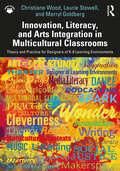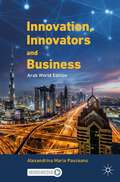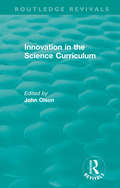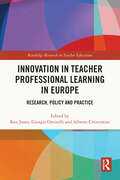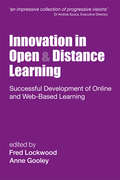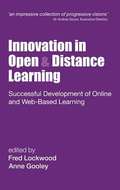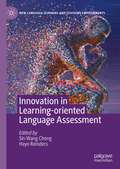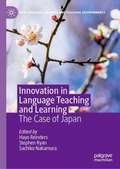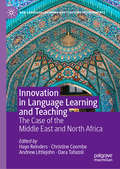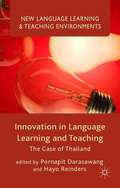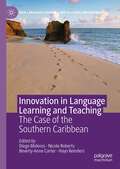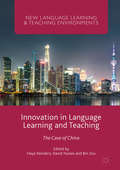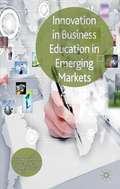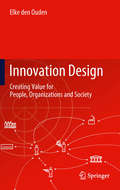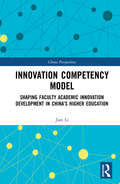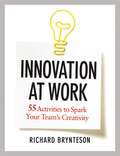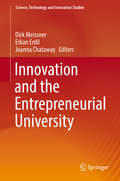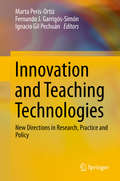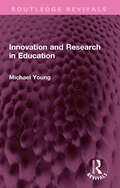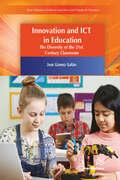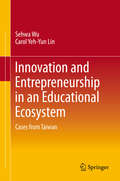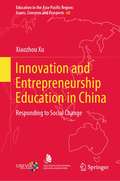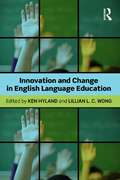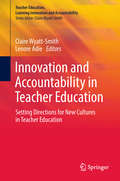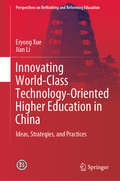- Table View
- List View
Innovation, Literacy, and Arts Integration in Multicultural Classrooms: Theory and Practice for Designers of K-8 Learning Environments
by Christiane Wood Laurie Stowell Merryl GoldbergThis textbook offers a foundation for how literacy and arts integration interconnect to advance innovation, accessibility, and equitable classroom learning contexts for K-8 students. Balancing research-backed theory and classroom practice, this book helps readers understand the multiple perspectives, frameworks, and models necessary in the design of learning environments for diverse learners, including sociocultural theories of literacy, new and digital literacies, multiliteracies, culturally responsive pedagogy, critical pedagogy, and art. Written by an author team with decades of experience in teaching literacy, writing, and arts integration across a variety of learning environments, each chapter includes a basis of conceptual framing and research backed by functional case studies and practical classroom practices, as well as discussion questions. Written as a text for foundational literacy, arts integration, and education courses, Innovation, Literacy, and Arts Integration in Multicultural Classrooms offers an engaging, practical resource for both pre-service and in-service elementary and middle grade teachers and teacher educators.
Innovation, Innovators and Business: Arab World Edition
by Alexandrina Maria PauceanuThis textbook approaches innovation and innovators as two elements of an equation with business application. It discusses creativity, methods to develop creativity, design thinking, the lean startup and minimum viable product (MVP), personal development for entrepreneurs, charisma, franchising and cases from the UAE. It is designed to be a practical and up-to-date resource for an innovation and entrepreneurship course. It contains practical information about the innovation frameworks and their applicability, explanation of creativity and creative mindset, methods of innovation, design thinking in practice, lean startup methodology, charisma, setting up a business, go-to-market strategies, growth and change as well as franchise management. It comes with worksheets to help the reader in practicing. The book solves the need of having innovation resources in one place, well explained and exemplified for students, aspirant and existing entrepreneurs as well as innovation enthusiasts.
Innovation in the Science Curriculum (Routledge Revivals)
by John OlsonOf all the subjects in the school curriculum, science has been a most common target of the reformer’s zeal. As a consequence, school science has featured frequently in studies of change in evaluation exercises and has also attracted the interest of social scientists. There have been others who have studied the effects of innovation in this field not as evaluators, nor as scientists, but as students of curricular problems. Such work is represented in this book, originally published in 1982. It is particularly concerned with the way in which teachers use innovation and how this can assist policy making in the curriculum field. By focusing on the science curriculum the contributors examine in detail the way in which teachers cope with daily problems and with the demands that new ideas make on the systems to which they are accustomed. The relationship between the school and the community is also dealt with in these case studies, all of which have implications for policy and research in the curriculum field.
Innovation in Teacher Professional Learning in Europe: Research, Policy and Practice (Routledge Research in Teacher Education)
by Ken Jones Giorgio Ostinelli Alberto CrescentiniThis book presents critical perspectives on teacher professional learning and professional development as interpreted in 14 countries across Europe. Bringing together experts from across Europe, the book fulfils a need for a better understanding of the changing nature of teacher professional learning in national policy contexts and of the cultural differences existing between various systems. It discusses the new thinking that has emerged in the field of teacher education alongside new models that reflect the changing patterns and policies relating to the ways educational professionals maintain and enhance professional practice. The book highlights that new models of teacher leadership and practitioner inquiry have a strong focus on pedagogy and social justice. It also examines briefly the challenges brought about by the Covid pandemic and the ways in which new approaches to professional learning, specifically the use of new technologies, have begun to transform practice in some countries in Europe. The book gives insights into the ways in which professional learning policy is interpreted and applied in practice. It will be highly relevant for researchers and post-graduate students in the fields of teacher professional learning and development, school leadership, comparative education and educational policy and planning.
Innovation in Open and Distance Learning: Successful Development of Online and Web-based Learning (Open and Flexible Learning Series)
by Fred Lockwood Anne GooleyThis volume draws together experiences in the application of technology to distributed learning. It offers an appraisal of the strategies and processes for managing change in open and distance learning and presents a progressive vision for all those involved in this widespread discipline.
Innovation in Open and Distance Learning: Successful Development of Online and Web-based Learning
by Fred Lockwood Anne GooleyOpen and distance education is now widespread, not just in the open universities of the world, but in all education and training sectors, from traditional campus universities to corporate training centers.With contributions from some of the world's leading practitioners in the field, this book draws together contemporary experience in the application of technology to distributed learning. It will be a valuable guide to all those implementing web-based learning. It provides a thought provoking appraisal of the strategies and processes for managing change in open and distance learning and offers a progressive vision for all those involved in this widespread discipline.
Innovation in Learning-Oriented Language Assessment (New Language Learning and Teaching Environments)
by Sin Wang Chong Hayo ReindersThis edited book documents practices of learning-oriented language assessment through practitioner research and research syntheses. Learning-oriented language assessment refers to language assessment strategies that capitalise on learner differences and their relationships with the learning environments. In other words, learners are placed at the centre of the assessment process and its outcomes. The book features 17 chapters on learning-oriented language assessment practices in China, Brazil, Turkey, Norway, UK, Canada, Japan, Saudi Arabia, and Spain. Chapters include teachers’ reflections and practical suggestions. This book will appeal to researchers, teacher educators, and language teachers who are interested in advancing research and practice of learning-oriented language assessment.
Innovation in Language Teaching and Learning: The Case of Japan (New Language Learning and Teaching Environments)
by Stephen Ryan Hayo Reinders Sachiko NakamuraThis book examines a wide range of innovations in language learning and teaching in Japan. Each of the chapters describes the impetus for a change or new development in a particular context, from early childhood to adult learning, details its implementation and provides an evaluation of its success. In doing so, they provide a comprehensive overview of best practice in innovating language education from teaching practice in formal classroom settings, to self-directed learning beyond the classroom, and offer recommendations to enhance language education in Japan and beyond. The book will be of interest to scholars of applied linguistics and language development, and in particular to those involved in managing change in language education that attempts to mediate between global trends and local needs.
Innovation in Language Learning and Teaching: The Case of the Middle East and North Africa (New Language Learning and Teaching Environments)
by Christine Coombe Hayo Reinders Andrew Littlejohn Dara TafazoliThis edited collection presents a study of innovation in teaching, learning, assessment and teacher development practices in the Middle East and North Africa (MENA). The thirteen research-based chapters in this collection examine recent innovations in English language teaching, drawing on classroom, administrative and learning experiences from seven of the countries in the region. The major trends analyzed across the volume include the language skills of reading and writing and the prevalence of technology and technology-enhanced instruction. It highlights that innovative teaching, learning and assessment practices that are now in place in virtually all levels of English language teaching and learning from primary school to university to adult education sectors, and reflects on possible ways forward for innovation in the field of ELT. This book will provide valuable insight for scholars of applied linguistics and practitioners working in language policy,
Innovation in Language Learning and Teaching
by Pornapit Darasawang Hayo ReindersHow does innovation in language teaching come about? This book covers the ways in which new developments in areas of language teaching practice, such policy-making, planning, methodology and the use of educational technology spread globablly and are adopted, rejected or adapted locally. By looking at the drivers, stakeholders, obstacles and affordances in one specific context – Thailand in the case of this book - it is possible to gain a deeper insight into the ways in which change processes occur. This will help anyone involved in language development, from curriculum reform to materials development, and from programme evaluation to the setting of assessment standards. The chapters in this book cover all aspects of language education in Thailand, from the primary to tertiary levels in both private and public education, as well as innovations at local, regional and national levels. The book will be of particular interest to those involved in managing change in language education that attempts to mediate between global trends and local priorities.
Innovation in Language Learning and Teaching: The Case of the Southern Caribbean (New Language Learning and Teaching Environments)
by Diego Mideros Nicole Roberts Beverly-Anne Carter Hayo ReindersThis book presents a unique perspective from an underrepresented region in the Global South. The volume features four different countries in the region: Barbados, Guyana, St. Lucia, and Trinidad and Tobago, as well as Martinique, an island located just north of St. Lucia which is an overseas region of France. It documents innovations in learning and teaching Spanish, French, and Chinese in the case of the English-speaking countries, and English as a foreign language (EFL) in the case of Martinique. The chapters cover different aspects of language education in the Caribbean and will be of particular interest to those involved in managing change in language education that attempts to mediate between global trends and local needs.
Innovation in Language Learning and Teaching
by Hayo Reinders David Nunan Bin ZouThis book investigates the ways in which new developments in areas of language teaching practice, such policymaking, planning, methodology and the use of educational technology spread globally and are adopted, rejected or adapted locally.
Innovation in Business Education in Emerging Markets
by Ilan Alon Victoria Jones John R. McintyreEmerging market economies account for eighty percent of the world's population and some 75% of its trade growth in the foreseeable future, following US Department of Commerce data. This volume provides insights for success in rapidly growing education markets that can be used by educators, administrators, policy makers and planners.
Innovation Design
by Elke Den OudenInnovation Design presents an approach to designing shared value for businesses, non-profit organizations, end-users and society. The societal and economic challenges we are currently facing - such as the aging population, energy scarcity and environmental issues - are not just threats but are also great opportunities for organizations. Innovation Design shows how organizations can contribute to the process of generating value for society by finding true solutions to these challenges. And at the same time it describes how they can capture value for themselves in business ecosystems that care for both people and planet. This book covers: creating meaningful innovations that improve quality of life, engage users and provide value for organizations and other stakeholders, guiding the creation of shared value throughout the innovation process, with a practical and integrative approach towards value that connects ideas from economics, psychology, sociology and ecology, designing new business models and business ecosystems to deliver sustainable benefits for all the involved parties and stakeholders, addressing both tangible and intangible value. Innovation Design gives numerous examples of projects and innovations to illustrate some of the challenges and solutions you may encounter in your journey of designing meaningful innovations and creating shared value. It also offers practical methods and tools that can be applied directly in your own projects. And in a fast-changing world, it provides a context, a framework and the inspiration to create value at every level: for people, for organizations and for the society in which we live.
Innovation Competency Model: Shaping Faculty Academic Innovation Development in China’s Higher Education (China Perspectives)
by Jian LiContributing to the discussion over China’s higher education development, this book takes a theoretical approach to address the topic of university academics’ innovation by introducing an academic innovation competency model, exploring the contexts, concepts and practices. The innovation competency model comprises three interdependent dimensions, including the academic internal drive vitality, the academic synthesizing refined ability and the academic suspected and introspective ability. By enriching the theory of professional development of university teachers, these three dimensions will help advance the reform of college personnel systems and ultimately improve the quality of China's higher education. The book will be valuable to researchers, students and stakeholders hoping to learn about education reform in China, or to those who study higher education management and comparative education.
Innovation at Work: 55 Activities to Spark Your Team's Creativity
by Richard BryntesonMore and more organizations are realizing that the only hope for survival in an ultracompetitive landscape is through innovation: developing new and better products and services - and creating efficient processes for delivering them. Designed for managers, team leaders, and trainers looking to promote innovation at work, the book is packed with 55 activities to help participants: - Employ "visioning" and "brainwriting" processes to achieve breakthroughs - Cultivate a sense of curiosity and inquisitiveness - Utilize methods of deep observation - Build networks for open source innovation and creative collaboration - Use images to spark ideas and connections - Develop out-of-the-box techniques for problemsolving - Deal with failure successfully and productively - Spot trends and determine "the next step" Innovation at Work contains worksheets, questions, and case studies to inspire discussion as well as assessments for determining managers' openness to innovation. Innovation isn't just about the next iPod, and it's not just for scientists. This handy book provides readers with a roadmap for fostering creativity and innovation in any team in any industry.
Innovation and the Entrepreneurial University (Science, Technology and Innovation Studies)
by Dirk Meissner Erkan Erdil Joanna ChatawayThe book explores different approaches towards the ‘entrepreneurial university’ paradigm, explores channels and mechanism used by universities to implement the paradigm and contributes to the public discussion on the impact of commercialization on university research and knowledge. It argues that different types of university-industry interaction may have repercussions even on funding of basic research if an appropriate balance is ensured between the two. University activities – both research and education in all forms – should provide economic and social relevance directed towards open science and open innovation. This book adds value to current knowledge by presenting both a conceptual framework and case studies which describe different contexts.
Innovation and Teaching Technologies
by Marta Peris-Ortiz Fernando J. Garrigós-Simón Ignacio Gil PechuánThis book focus on organizational changes that are taking place in higher education Universities are currently experiencing a period of change and restructuring into what is known as the European Higher Education Area (EHEA). EHEA represents a process of educational reform based on three types of transformations: structural, curricular and organizational. The integration of universities in this new EHEA is bringing conceptual and methodological changes not just to the structure of university education, but also to the teaching-learning processes and the conditions under which they take place. EHEA is prompting a change in the teaching model towards the consideration of students as the main actors in the educational process. This change requires new teaching strategies where students are asked to resolve problems with tools provided by the teacher This book presents ideas, results and challenges related to new information and communication technologies, innovations and methodologies applied to education and research, as well as demonstrating the latest trends in educational innovation.
Innovation and Research in Education (Routledge Revivals)
by Michael YoungOriginally published in 1965, this title looks at programmed learning, language laboratories, curricular reform, educational television, team teaching – these are just some of the fashions that were going to change education in the following decade quite as much as the introduction of comprehensive schools. Would anyone ever know what their effects are? Not unless there was a great expansion of research. The author of this book states the need for a marriage of innovation and research. The social sciences could gain as much as education. Today it can be read in its historical context.
Innovation and ICT in Education: The Diversity of the 21st Century Classroom
by José Gómez GalánThe adequate integration of information and communication technologies (ICT) in educational and training processes is one of the biggest current challenges in education. The classroom of the present is very different from just a few decades ago, new technological tools are completely transforming its characteristics and activities. This internationally authored book offers a timely, effective and practical vision of this new educational scenario.The book takes a multidisciplinary approach in looking at the problems and possible solutions that are faced by the educational professional of the 21st century when, by necessity or obligation, they face the use of ICT in their daily tasks. Divided into two parts, one theoretical and another practical, this book offers the highlights of the most important lines of research that are being developed today in educational technology, and importantly presents the innovations which have had the most impact over recent years. From the profound transformations in the physical classroom to everything that involves new virtual scenarios, where online teaching requires innovative strategies and training processes, this book describes the diverse scenarios that ICT has generated and will continue to generate in the field of education. It presents a new and a very different type of education that can be adapted to the needs of the citizen of the digital society.
Innovation and Entrepreneurship in an Educational Ecosystem: Cases from Taiwan
by Carol Yeh-Yun Lin Sehwa WuThis book reports on 12 education innovation cases in Taiwan and focus particularly on an ecosystem to demonstrate innovation as a competitive advantage and requires an ecosystem to be sustainable in virtually all disciplines. It also covers the trend of education innovation in many countries, with “education entrepreneurship” being the frequently used description. The 12 educators highlighted here are even more entrepreneurial than many businesspeople. Generally, schools are required to follow certain rules, especially the public schools. Accordingly, the book also describes how these education entrepreneurs have innovatively created a fostering environment under challenging constraints to facilitate the success of students, teachers, and even the local community. Six of the cases involve school-based innovation, while the other six focus on student-based innovation. Their stories provide valuable insights for all companies seeking to become more innovative in a resource-constrained setting.
Innovation and Entrepreneurship Education in China: Responding to Social Change (Education in the Asia-Pacific Region: Issues, Concerns and Prospects #60)
by Xiaozhou XuThis book explains the strategic appeal of innovation and entrepreneurship education based on the systematic analysis of the key characteristics and constraints of China’s economic transformation and upgrading. The book presents results related to studying the common trends of innovation and entrepreneurship education at the times of economic globalization and the experience of major countries, exploring the cultivation model of key innovation and entrepreneurship talents and mechanism of the innovation and entrepreneurship education ecosystem. Based on ecology and system theory, this book puts forward the concept of “global ecology” to explain the complex relationship among various elements in the process of innovation and entrepreneurship education.
Innovation and change in English language education
by Ken Hyland Lillian L. C. WongQuestions about what to teach and how best to teach it are what drive professional practice in the English language classroom. Innovation and change in English language education addresses these key questions so that teachers are able to understand and manage change to organise teaching and learning more effectively. The book provides an accessible introduction to current theory and research in innovation and change in ELT and shows how these understandings have been applied to the practical concerns of the curriculum and the classroom. In specially commissioned chapters written by experts in the field, the volume sets out the key issues in innovation and change and shows how these relate to actual practice offers a guide to innovation and change in key areas grounded in research relates theory to practice through the use of illustrative case studies and examples brings together the very best scholarship in TESOL and language education from around the world This book will be of interest to upper undergraduate and graduate students in applied linguistics, language education and TESOL as well as pre-service and in-service teachers, teacher educators, researchers and administrators keen to create and manage teaching and learning more effectively.
Innovation and Accountability in Teacher Education: Setting Directions for New Cultures in Teacher Education (Teacher Education, Learning Innovation and Accountability)
by Claire Wyatt-Smith Lenore AdieThis is the foundational book for the new series, Teacher Education, Learning Innovation and Accountability. The book canvasses research, practice and policy perspectives in teacher education across diverse geographic, social and political contexts. It explores the lifespan of teacher development from initial preparation through to graduate classroom practice as it occurs in an intensifying culture of standards and regulation. The characterization of initial teacher education (ITE) in a crucible of change permeates throughout the book. The chapters open up new ways of thinking about innovation and accountability in ITE and the professionalization of teaching, exploring fundamental questions, such as “Who are the actors in teacher preparation and how do they interact? How can we learn about the quality of teacher education? Where can we hear the voices of teacher educators and preservice teachers, as well as school-based teacher educators? What are the new and emerging roles of others in teacher education who have not been involved previously, including employing authorities?” (p. 22). While the book provides responses to these and other provocative questions, it also offers new insights into innovative teacher education from a wide range of policy and practice contexts.
Innovating World-Class Technology-Oriented Higher Education in China: Ideas, Strategies, and Practices (Perspectives on Rethinking and Reforming Education)
by Jian Li Eryong XueThis book examines how to create world-class, technology-oriented innovation in higher education in China. It also proposes a model in response to the demand for promoting scientific and technological advances and technological innovation in the Chinese higher education system. Moreover, the book explores key concepts, pathways, models, policies, practices, trends and implications, and offers insights into fostering innovation in higher education. Lastly, it discusses how public policy theories can be applied to promote university technology transfer in order to create world-class universities in today’s China.
